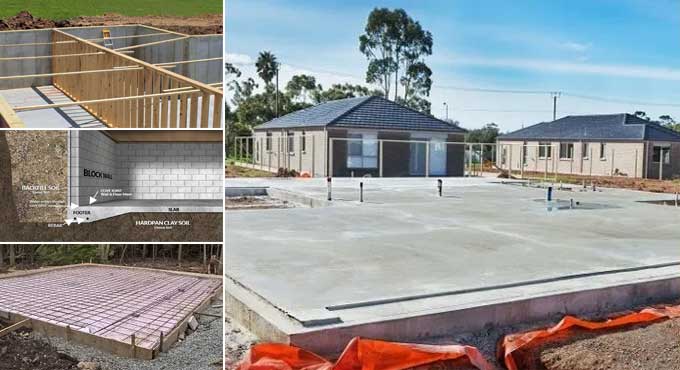
Advantages & Disadvantages of Monolithic Slab Foundation

Concrete slabs and footings form with monolithic slab foundations using a single layer of concrete. Monolithic foundations are preferred because they reduce labor costs and make construction faster than other foundation types.
The footing of a monolithic slab foundation is typically 12 to 18 inches thick, while the slab is 4 to 6 inches thick. Monolithic foundations require an appropriately prepared site and reinforced concrete with wires and reinforcing bars.
Preparation of the Site
1. The soil beneath the slab is devoid of organic matter. Compacting and removing the topsoil is necessary.
2. It is up to the code enforcement to determine the type and placement of reinforcements. Monolithic slabs of '4' rebar are commonly used. Metal bars called rebar places overlap, and you bind them together by placing them side by side in trenches.
3. Thick edges are the result of the trench along the edge of the slab. The depth and width of trenches are determined by building code officials. Warm climates use trenches that are 1 foot wide and 1 foot deep, while frost-heaved environments use trenches that are 1 foot wide and 2 feet deep.
Advantages of Monolithic Slab Foundation
Monolithic foundations offer many advantages over traditional ones. There are several advantages to this:
A. A concrete floor can pour as soon as the perimeter trench adds and gravel spreads.
B. The foundation dries faster than any other foundation.
C. Strong foundation: Anchor bolts and reinforcements must be correctly installed for this foundation to be strong.
D. Easily maintained: Monolithic foundations need only inspect regularly to ensure they don't crack.
E. Energy-efficient: There isn't a gap between the home and the ground, so less energy wastes. Under the subfloor, air cannot travel.
Disadvantage of Monolithic Slab Foundation
Monolithic foundations have disadvantages. Below are a few cons of this kind of foundation:
1. Approximately one foot of height has been added to your home, which puts you at risk of flooding. The house sits 6 inches above the ground line, so flooding is a concern.
2. Repairing a cracked foundation can be very costly: When a crack appears in the foundation, expensive methods need to be used to fix the problem.
3. The value of the property may diminish.
A Timely Choice of Monolithic slabs
Slab foundations are ideal for several applications. It's a good choice for climates that don't freeze, don't get too hot, and aren't like a desert either. A monolithic slab can be used in place of a basement or crawlspace if one isn't necessary.
What are some issues with a Monolithic Foundation
Monolithic foundations are convenient and easy to install, but they could compromise by issues that arise. A traditional foundation can be cheaper to install than a foundation that requires expensive repairs.
Cracks typically develop in other areas of the house supported by a monolithic foundation.
1. There is a lot of concern about foundation cracks. Cold joints can separate the foundation from the wall when there are cracks in the foundation. Water, moisture, and insects can easily enter through the narrow openings.
2. A building's foundation can be damaged by moist soil or by improper construction. Uneven floors, walls, and countertops in the home may result.
3. As a result of shifting foundations, windows and doors may stick or crack in the sheetrock.
Example of an ideal construction scenario to avoid Monolithic Slab Foundations
1. Monolithic slab foundations should not use in certain situations, such as monopour.
2. A steep site will require pouring a lot of concrete, which will be expensive.
3. A concrete crack occurs when a home sits on a lot with many dirt-filled holes.
4. The building code prohibits monolithic slab foundations in flood zones.


